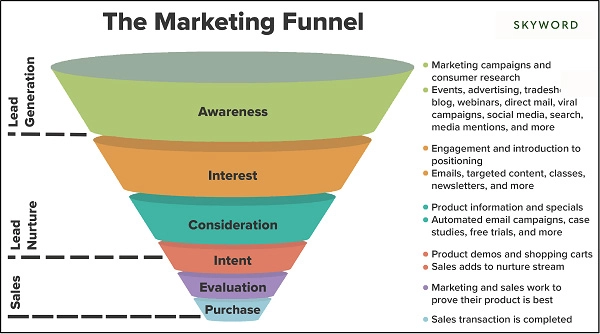
Introduction
Generating leads is a priority for every company – whether big or small.
This is because business must continually initiate customer interest in order to sell more and grow. But, in reality, not every person who interacts with your company will be ready to make a purchase.
As a matter of fact, statistics show that 63% of people who ask for information from companies do not buy a product or service until after three months. Top of funnel leads are prospects that become aware of your company’s products or services for the very first time. Often, these are people who are in the initial stage of the buyer’s journey – hence top of marketing funnel.

The B2B buying process is significantly longer than B2C as multiple decision makers are involved in the decision making process. Available data shows that on average, 5.4 people are involved in making purchase decisions in B2B companies.
Top of funnel marketing plays the important role of identifying prospects who are not sales ready, but are likely to buy in future. In simple terms, this type of marketing focuses on creating brand awareness among audiences that are known and unknown to your company.
Once they learn about your company and what it offers, top of the funnel leads begin moving down the sales funnel to become marketing qualified leads (MQLs). A top of funnel lead is considered an MQL when, by virtue of the company or position, the lead takes actions either through email communication or on the website, that appears like it is a good prospect to pursue through sales outreach.
Key Characteristics of MQLs
- Website History
- Take Actions
- Engagement on Social Media
There are several characteristics that make it easy for companies to identify MQLs. These characteristics include:
1. Website History
As they research available solutions, MQLs visit your site severally. A detailed study of web visitors will reveal a pattern in terms of pages visited and the pages where MQLs spend more time. This shows that they are interested in the solutions that you offer. Your website will certainly attract all kinds of visitors – but, if you notice visitors who have come back to your site, and spent a significant amount of time on some pages, those are most likely MQLs.
2. Take Actions
MQLs don’t just visit your website or social media pages, they take certain actions before leaving those pages. There is a wide range of actions that show top of the funnel leads are quickly becoming MQLs. They include:
- Downloading content: If you have downloadable content like ebooks, guides, reports or whitepapers available on your site, MQLs will download it
- Running product demos: Some products are complicated for customers to figure out how to use them by themselves. If your company has created a product demo and uploaded it online on social media pages or company websites, MQLs will run the demos to learn more about your offerings.
- Completing forms: If you have created lead capture forms to help you capture details of prospects or customers, MQLs willingly complete the forms and submit them to you
- Sharing personal information: MQLs tend to willingly share personal information with companies that demonstrate ability to solve their issues. Most B2B marketers require leads to share their personal information like email address, phone number, name, location and title to help with targeted lead nurturing
- Requesting for additional information: MQLs can send enquiries to companies through contact forms or emails. They may also click on product or service ads that a company has online available online
3. Engagement on Social Media
MQLs tend to engage with companies more on social media, and even on websites. For instance, these leads leave comments on social media or blogs posted on company websites. They also leave social media impressions such as likes and dislikes,
Identifying MQL Engagement Patterns Using Automation Tools
- Email Open Rates
- Click-Through-Rates
- Unsubscription Rate
- Lead Scoring
- Conversion Rates
Estimates show that at least 37% of B2B marketers use marketing automation to generate leads. Automation tools are useful in moving leads through the various stages of the sales funnel. B2B marketers that use automation platforms are able to run free autoresponder campaigns that are triggered by actions taken by MQLs.
For instance, a company can send a series of email messages to MQLs after they sign up for a product trial. Since automation tools are triggered by actions taken by leads, they can play an instrumental role in helping B2B companies identify engagement patterns of MQL. Here are some metrics that you’ll need to pay attention to determine MQL engagement patterns:
1. Email Open Rates
Automation tools enable marketers to automate as well as personalize the emails that go out to prospects. After sending the emails, tracking their open rates becomes an important metric to track to understand how those prospects are engaging with the content. In very basic terms, email open rate is the percentage of people who receive and open the email. Emails are considered to have been opened once the images and HTML have been displayed. A high email open rate means that MQLs are interested in your content, and are therefore engaging with it.
2. Click-Through-Rates
This is the percentage of prospects who click and open the links that you include in your email content. Click-through-rates indicate that MQLs are engaging with your content. They find it interesting and relevant, hence the willingness to learn more.
3. Unsubscription Rate
This metric tells you the rate of prospects that unsubscribe from your mailing list. While it is inevitable to have people unsubscribing from your mailing list, this rate should remain below 1%. A higher unsubscription rate shows negative MQL behavior – which means low engagement with your content. Unsubscriptions could mean that your content is not interesting nor relevant to your MQLs.
4. Lead Scoring
Once a prospect becomes a lead, marketers begin to score it throughout the nurturing process. This means ranking the prospects based on a pre-designed scale that reflects the perceived value that each lead presents to the company. A key element in lead scoring is prospect’s engagement. The more leads engage with a company’s content, the higher they score.

5. Conversion Rates
Automation tools come in handy in helping B2B marketers identify MQLs that convert at different marketing funnel stages. For instance, marketers can track the percentage of prospects that converted to become MQLs and the percentage of MQLs whose engagement converted them into opportunities.
Why Expecting Conversion From MQLs Could Be Too Soon
The engagement levels of MQLs show that they are more inclined towards making a purchase, more than top of the funnel leads. But this does not mean that they’ll be making a purchase soon. MQLs in the B2B space take time to research. For these buyers, purchase decisions are also not a preserve of one person – multiple decision makers are involved.
As such, their engagement with your company’s content may not necessarily mean they are ready to convert soon. Some MQLs may take a longer period of time. They may remain in the middle of the funnel for an extended period of time before converting into sales qualified leads. Rather than expecting MQLs to convert fast, B2B marketers should focus on nurturing them until they become sales ready. As MQLs move from interest to consideration stage, continue engaging them through targeted content, email newsletters, product information and case studies.

When Nurtured the Right Way, MQLs Turn Out To Be Gold
Statistics show that 84% of marketers prefer high quality leads as opposed to quantity, when qualifying MQLs.
This makes sense because being at the top of the funnel, MQLs can be challenging to qualify in the lead generation process. Marketing teams however, can look at a broad range of touchpoints to narrow them down. Some of these touchpoints include email subscriptions, content downloads, webinar or course sign ups, initiating contacts, viewing product demos, or playing items in shopping carts.
When identified and nurtured the right way, MQLs can become a goldmine for the sales team – as their needs get well aligned to the company’s offerings. Of importance to note is that it takes proper utilization of time, efforts and resources to boost conversion of MQLs and SQLs.
One of the main benefits that companies reap by nurturing MQLs is that sales teams are able to close deals more efficiently and faster. This boosts sales revenue for the companies and places them ahead of the competition. Also, less effort and time is wasted in the sales pipeline because MQLs are effectively nurtured to become sales-ready.
Final Thoughts
Top of the funnel leads are critical for any business. Sales reps are always in need of new leads to help them realize their revenue goals. This means that businesses must constantly prioritize generation of new leads. Marketers address this need by generating new leads at the top of the sales funnel.
Decoding their behavior enables B2B marketers to nurture them down the funnel effectively. As part of the top of the funnel leads, MQLs have a high chance of converting into customers. Though they may take time to convert, it is always worth the effort to nurture them through automated email campaigns.
Our blog
Latest blog posts
Tool and strategies modern teams need to help their companies grow.

In the absence of a solid lead scoring system, your sales team will spend time pursui...

Programmatic ABM combines the effectiveness of targeted engagement with automation. I...

Take advantage of the year-end holiday rush so you can boost your SaaS revenue and st...





